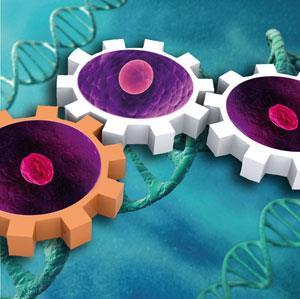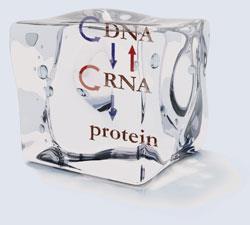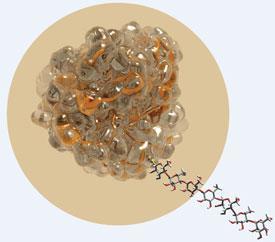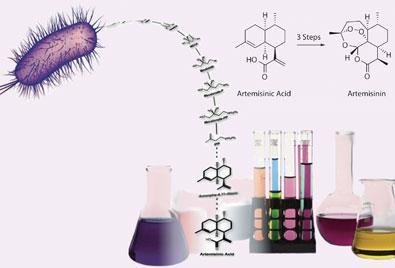Work in the fashionable new field of synthetic biology is gathering pace. Hayley Birch looks into some of the latest developments in a rapidly evolving area
Work in the fashionable new field of synthetic biology is gathering pace. Hayley Birch looks into some of the latest developments in a rapidly evolving area
If nature was a company, it would be a pretty tough competitor. Think about it: it manufactures millions of different products - and that’s only taking into account its protein range - and has come up with some rock solid systems that underpin its entire industry, perhaps most notably the so-called central dogma of molecular biology, a concept first articulated by Francis Crick: ’DNA makes RNA makes protein’.
Fortunately for science, nature doesn’t hold any patents, so it’s simply a case of understanding the product, or the process, and copying it, with the odd adjustment here and there to turn it to our advantage. Aspirin, one of the most widely used painkillers today, is famously only a tweak away from salicylic acid - a plant hormone found in willow bark, from whence the drug originated. More recently, scientists found a new way to borrow from nature when they invented genetic engineering.

Now, in the 21st century, scientists have decided it’s time for a re-design. New generations of chemical engineers and systems biologists are banding together to form a rival company and they’re calling it Synthetic Biology. Not content with biological tinkering and frustrated by the limitations imposed by nature’s archaic systems, synthetic biologists are instigating a drastic overhaul. For some, this goes as far as re-conceptualising the whole protein-making business to expand the range of available products and functions.
As far as applications go, it depends on who you ask. Biofuels, drugs, sensors and bioremediation are all widely quoted, but some insist the field is so young that it’s too early to say. Still, when you’re re-engineering biology itself, why draw a line?
Beating the system
By some analogies, synthetic biology is more akin to engineering than to biology itself. The community has even created a Registry of Standard Biological Parts for building biological systems and devices. Richard Kitney, a biomedical systems engineer at Imperial College London, UK, explains that synthetic biologists employ the engineering concept of modularity. ’You produce standard systems from standard devices and standard parts,’ he says. ’So what this means is that you don’t have to go back to square one every single time. You can actually build something complex from tried and tested devices which you produce from tried and tested parts. This is really key and in my opinion a big difference between synthetic biology and, say, genetic engineering.’
Jason Chin, an expert in protein and nucleic acid chemistry at the University of Cambridge, UK, says the field is driven not by specific applications, as genetic engineering often is, but by trying to understand the principles by which cells and organisms can be rationally engineered. It’s not just about building new molecules, such as humanised antibodies; it’s about stringing together entire biochemical or signalling pathways inside cells to produce predictable outputs.

The problem with trying to engineer whole new pathways into cells, however, is that the natural pathways tend to interfere - often in complex ways that can be difficult to pick apart. One approach that Chin’s team has taken to dealing with this interference is to build what are called orthogonal components. ’These are really specifically designed key molecules - or versions of those molecules - in the cell that don’t interact with the endogenous molecules,’ says Chin. ’They specifically interact with molecules that we want them to interact with to propagate a signal.’
His team is building a whole new system for translating ribonucleic acid (RNA) into the amino acid sequences of proteins. The plan is to defrost the ’frozen accident’ of the genetic code - frozen, Chin says, because all the machinery that enforces it is universal. As such, not only has Chin made new versions of the adaptor molecules - transfer RNAs or tRNAs - and key enzymes called amino acyl tRNA synthetases, that orchestrate this process, they have also engineered new ribosomes, which are the complexes that assemble the polypeptide chains. They are currently able to use these new parts and devices to make proteins containing a few unnatural amino acids, but in the long term hope to make completely unnatural polymers that are inheritable properties of the cell.
Chin’s system runs in tandem with the cell’s own protein production system. So is the intention, eventually, to replace the natural system altogether? ’I think part of what we’re doing is saying that the cell does all these things and it does them really well, and so why not just take advantage of that and add to it?’ he muses. ’There are people that are interested in completely recapitulating natural biology in vitro. That’s not the sort of thing we’re interested in. We’re interested in asking the question: if you take current life, can you synthetically evolve it towards a life form that has more rather than replacing what already exists?’
According to Ben Davis, a chemical biologist at the University of Oxford, UK, it should be possible to avoid Crick’s central dogma - his protein-producing ’conveyor belt’ system - altogether, by using chemistry to reprogram proteins directly. He thinks the scope of natural protein manufacture is somewhat restricted, because it only uses 20 amino acids. ’Of course, nature’s clever, but it’s massively limited,’ he says. ’Why can’t we make 200 different amino acids, or 2000, and have all the gradations of colour and function we want in a protein? So if I had to guess the way things might go, I think synthetic biology will be like that.’
Creating new functions
Recently, however, Davis has been exploring another system for expanding the functions of proteins. His team is using a chemical tagging approach that allows selective attachment of carbohydrates to proteins made in bacteria, thus creating an array of synthetic glycoproteins. The tags are specific functional groups in natural or unnatural amino acids that can be introduced through changes in the DNA sequence. These functional groups single out tagged proteins for modification via glycosylation reactions.
One of Davis’s new glycoproteins has a very obvious real world application - it turns disease blue. By combining two chemical tags and their subsequent modifications, the team created a site that could bind the human inflammation protein P-selectin, found on the inside of blood vessels. P-selectin acts like a hand that sticks out to grab white blood cells and drag them to sites of inflammation, where they help to defend against disease. The new synthetic protein is designed to ’shake hands’ with P-selectin by mimicking the binding site on the immune cells.

’We’ve given this synthetic protein a new ability - to release a colour that can then be used to image disease - and we’ve coupled it with MRI to image in a non-invasive way,’ explains Davis. ’We’ve used this in animal models of multiple sclerosis and we’ve found that we can do similar things with cerebral malaria. The thing that most people die from with malaria is cerebral malaria - brain infection - so if you can spot that happening earlier, you know you’ve got danger. But nature doesn’t have a way of doing that. It just fights the disease.’
Thus, although experts stress the field of synthetic biology is at a relatively early stage, it is difficult not to be drawn in by the apparently wide-ranging implications for medicine. One of the projects that has become something of a poster child for synthetic biology is Jay Keasling’s re-engineering of Brewer’s yeast, Saccharomyces cerevisiae , to manufacture a precursor for the anti-malarial drug artemisinin (see Chemistry World, July 2008, p44). The drug can be extracted from sweet wormwood, but its price tag puts it out of reach of those who need it most. Keasling, who heads up the synthetic biology engineering research center at the University of California, Berkeley, constructed a synthetic artemisinin production pathway in yeast using genes from the wormwood plant to create a cheaper source of the drug.
Keasling explains that the feat involved substantial reengineering of the yeast’s metabolism by insertion of at least a dozen genes. ’This is why it became a synthetic biology project; because of the magnitude, but also because of the very fine control we needed over all of the genes in the metabolic pathway to take a central intermediate - acetyl-CoA - and turn it into artemisinin, the anti-malarial drug,’ he says. Scale-up for mass production is currently underway in partnership with Amyris Biotechnologies, California, with arrival on the market predicted by 2010-2011.
According to Kitney, the original artemisinin project was simply an extension of metabolic engineering, but the second generation involves true synthetic biology principles - the division of metabolic pathways into what could loosely be called devices, which come together to produce the overall network or drug. Keasling says the approach provides a template for producing a whole family of different chemicals, including relatives of artemisin that could be used to combat resistance to the drug; the chemotherapy drug Taxol; and biofuels - to which he and Amyris are now turning their attention.

’We’ve created a microbe that is a platform for synthesising chemicals like artemisinin and it turns out that this family of chemicals is very large,’ he says. ’Because they’re hydrocarbons, we’re now turning this project to try to synthesise biofuels using these platform microbes. We have to enhance them a little bit more to get the product at a higher titre and therefore lower cost, but it’s a very similar application.’
Starting life over
The elephant in the room where synthetic biology is concerned is, of course, artificial life - cells and organisms made entirely synthetically. While the immediate aims may be re-engineering natural molecules and pathways, and the insights that these undertakings provide, such pursuits are inevitably opening up the possibilities for re-designing life itself - a target that scientists such as J Craig Venter are already striving for (see Chemistry World , July 2008, p48).
Davis recently created a form of artificial cell with life-like characteristics. His ’protocell’ is a synthetic lipid-bound container that synthesises sugars in response to a change in pH of its surroundings. The sugars allow the protocell to communicate with bacteria through the medium of quorum sensing - a type of cell-to-cell signalling usually only seen in bacterial populations. Having noticed the similarity between quorum signalling molecules recognised by the bioluminescent bacterium Vibrio harveyi and the sugars produced by his protocells, Davis wondered what would happen if the two were housed together. Sure enough, the protocell’s synthetic sugars caused the bacterium to light up just as it would in response to signals from natural bugs.
Synthetic ecosystems

Far from limiting themselves to synthetic molecules, or even cells, Lingchong You and colleagues at Duke University in California are creating entire synthetic ecosystems, albeit in bacteria. By re-engineering the natural communication systems (quorum sensing mechanisms) of Escherichia coli , they have been able to create two separate populations - a predator population and a prey population - that interact to control population density . The synthetic gene circuits they constructed cause the predators to produce an acyl-homoserine lactone as the prey population starts to increase. This chemical induces the expression of a suicide protein that kills off the prey. ’Essentially what you end up having is like a thermostat working at a population level, so the circuit can effectively control the population density,’ explains You. ’In building such complex systems we start off with some sort of conceptual design and then we build the mathematical models that will predict the consequence of the design. Then we go through the iterations of the implementation, revision, and sometimes revision of the mathematical model before eventually getting something that will be functional.’ Their aim is to understand more about how quorum sensing systems can be taken advantage of. The synthetic biology approach, says You, enables his team to refine portable design strategies that can be applicable in different contexts.
’It’s kind of a surprise. People said, "Well, is it alive?" and I said, "Of course it’s not." But it does talk to bugs and the bugs respond as though it’s alive, which is kind of intriguing - more weird than anything else,’ says Davis. ’If you think about it you could do anything you liked - put any reactions into the container. It needs to have a compartment for the thermodynamics, metabolism to fuel it and probably something to do with reproduction or information transfer. So suddenly you can say, well, if I can make anything that’s got a compartment, metabolism and can transmit information, then have I got something that’s alive? I don’t know.
And does it matter?’
Hayley Birch is a freelance science writer and editor based in Bristol.
References
MIT, 2009
K Wang et al, Nature Biotechnol., 2007, 25, 770 (DOI: 10.1038/nbt1314)
S I van Kasteren et al, Nature Protocols, 2007, 2, 3185 (DOI: 10.1038/nprot.2007.430)
D-K Ro et al, Nature , 2006, 440, 940 (DOI: 10.1038/nature04640)
P M Gardner, K Winzer and B G Davis, Nature Chem., 2009, 1, 377 (DOI: 10.1038/NCHEM.296)
F K Balagaddé et al , Mol. Syst. Biol., 2008, 4, 187 (DOI: 10.1038/msb.2008.24)






No comments yet